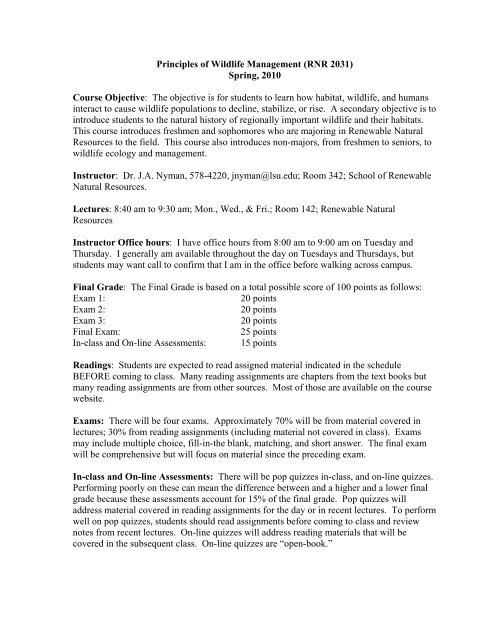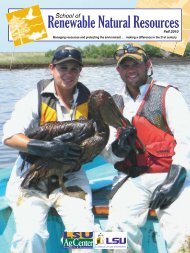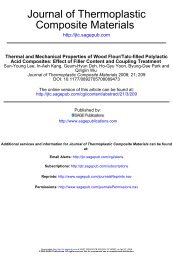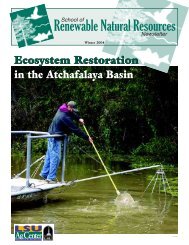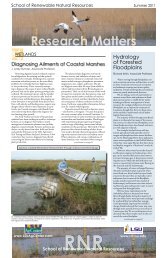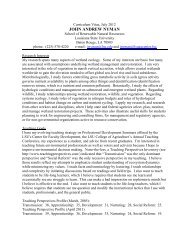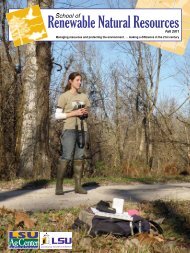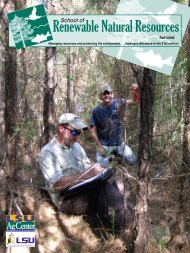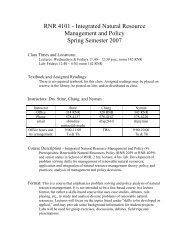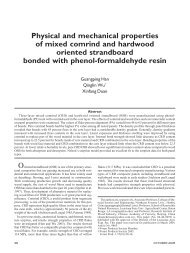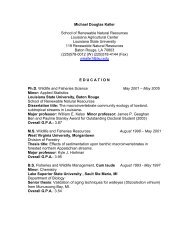syllabus - LSU School of Renewable Natural Resources
syllabus - LSU School of Renewable Natural Resources
syllabus - LSU School of Renewable Natural Resources
Create successful ePaper yourself
Turn your PDF publications into a flip-book with our unique Google optimized e-Paper software.
Principles <strong>of</strong> Wildlife Management (RNR 2031)<br />
Spring, 2010<br />
Course Objective: The objective is for students to learn how habitat, wildlife, and humans<br />
interact to cause wildlife populations to decline, stabilize, or rise. A secondary objective is to<br />
introduce students to the natural history <strong>of</strong> regionally important wildlife and their habitats.<br />
This course introduces freshmen and sophomores who are majoring in <strong>Renewable</strong> <strong>Natural</strong><br />
<strong>Resources</strong> to the field. This course also introduces non-majors, from freshmen to seniors, to<br />
wildlife ecology and management.<br />
Instructor: Dr. J.A. Nyman, 578-4220, jnyman@lsu.edu; Room 342; <strong>School</strong> <strong>of</strong> <strong>Renewable</strong><br />
<strong>Natural</strong> <strong>Resources</strong>.<br />
Lectures: 8:40 am to 9:30 am; Mon., Wed., & Fri.; Room 142; <strong>Renewable</strong> <strong>Natural</strong><br />
<strong>Resources</strong><br />
Instructor Office hours: I have <strong>of</strong>fice hours from 8:00 am to 9:00 am on Tuesday and<br />
Thursday. I generally am available throughout the day on Tuesdays and Thursdays, but<br />
students may want call to confirm that I am in the <strong>of</strong>fice before walking across campus.<br />
Final Grade: The Final Grade is based on a total possible score <strong>of</strong> 100 points as follows:<br />
Exam 1:<br />
20 points<br />
Exam 2:<br />
20 points<br />
Exam 3:<br />
20 points<br />
Final Exam:<br />
25 points<br />
In-class and On-line Assessments: 15 points<br />
Readings: Students are expected to read assigned material indicated in the schedule<br />
BEFORE coming to class. Many reading assignments are chapters from the text books but<br />
many reading assignments are from other sources. Most <strong>of</strong> those are available on the course<br />
website.<br />
Exams: There will be four exams. Approximately 70% will be from material covered in<br />
lectures; 30% from reading assignments (including material not covered in class). Exams<br />
may include multiple choice, fill-in-the blank, matching, and short answer. The final exam<br />
will be comprehensive but will focus on material since the preceding exam.<br />
In-class and On-line Assessments: There will be pop quizzes in-class, and on-line quizzes.<br />
Performing poorly on these can mean the difference between and a higher and a lower final<br />
grade because these assessments account for 15% <strong>of</strong> the final grade. Pop quizzes will<br />
address material covered in reading assignments for the day or in recent lectures. To perform<br />
well on pop quizzes, students should read assignments before coming to class and review<br />
notes from recent lectures. On-line quizzes will address reading materials that will be<br />
covered in the subsequent class. On-line quizzes are “open-book.”
Academic Honesty: The University Academic Integrity Policy states clearly that any form<br />
<strong>of</strong> plagiarism or cheating on exams or papers or complicity in such acts is punishable by the<br />
maximum penalty <strong>of</strong> expulsion from the university. The complete policy is published in the<br />
University Student Handbook. All students are expected to familiarize themselves with this<br />
policy and to understand its terms.<br />
Calculator: Students will need a calculator to calculate natural log and antilog on quizzes<br />
and exams.<br />
Reading Material:<br />
Text:<br />
Braun, C.E., 2005. Techniques for Wildlife Investigations and Management. The Wildlife<br />
Society, Bathesda, Maryland. (DON’T SELL THIS TEXT AT THE END OF THE<br />
SEMESTER IF YOUR AREA OF CONCENTRATION REQUIRES YOU TO TAKE<br />
RNR 4011 BECAUSE YOU’LL NEED THIS TEXT FOR THAT CLASS)<br />
Molles, M. C., Jr. 2005 or 2006, or 2007 or 2008 or 2009. Ecology: Concepts and<br />
Applications, 3 rd , 4 th , and 5 th Editions all are acceptable. McGraw-Hill, New York.<br />
(YOU MAY ALREADY HAVE THIS TEXT BECAUSE IT IS REQUIRED FOR RNR<br />
2101)<br />
Reading Assignments: Many <strong>of</strong> the assigned reading materials are available at the class<br />
website.<br />
Berger, J., P.B. Stacey, L. Bellis, and M.P. Johnson. 2001. A mammalian predator-prey<br />
imbalance: grizzly bear and wolf extinction affect avian neotropical migrants. Ecological<br />
Applications 11:947-960.<br />
Bolen, E.G., and W.L. Robinson. 2003. Wildlife ecology and management. Prentice Hall.<br />
New Jersey. 5 th edition.<br />
Boyer, M. E., J. O. Harris, and R. E. Turner. 1997. Constructed crevasses and land gain in<br />
the Mississippi River delta. Restoration Ecology. 5:85-92<br />
Brashares, J.S., P. Arcese, M.K. Sam, P.B. Coppolillo, A.R.E. Sinclair, and A. Balmford.<br />
2004. Bushmeat hunting, wildlife declines, and fish supply in West Africa. Science<br />
306:1180-1183.<br />
Caffey, R. H. and M. Schexnayder. 2003. Coastal Louisiana and South Florida: A<br />
Comparative Wetland Inventory, Interpretive Topic Series on Coastal Wetland<br />
Restoration in Louisiana, Coastal Wetland Planning, Protection, and Restoration Act.<br />
National Sea Grant Library.<br />
Coleman, J.M. 1988. Dynamic changes and the processes in the Mississippi river delta.<br />
Geological Society <strong>of</strong> America Bulletin 100:999-1015.<br />
Evans, S.B., L.D. Mech, P.J. White, and G.A. Sargeant. 2007. Survival <strong>of</strong> adult female elk<br />
in Yellowstone following wolf restoration. Journal <strong>of</strong> Wildlife Management 70:1372-<br />
1378.<br />
Estes, J.A., M.T. Tinker, T.M. Williams, and D.F. Doak. 1998. Killer whale predation on<br />
sea otters linking oceanic and nearshore ecosystems. Science 282:473-476.<br />
Etling, K. 2007. The brief convoluted history <strong>of</strong> Santa Rosa Island. American Hunter.<br />
National Rifle Association, Fairfax, Virginia. February, 2007, page 20.<br />
2
Gabrey, S.W., A.d. Afton, B.C. Wilson. 1999. Effects <strong>of</strong> winter burning and structural<br />
marsh management on vegetation and winter bird abundance in the Gulf Coastl Chenier<br />
Plain, USA. Wetlands 19:594-606.<br />
Gruber, N., and J.N. Galloway. 2008. An earth-system perspective <strong>of</strong> the global nitrogen<br />
cycle. Nature 451:293-296.<br />
Hames, R. 2007. The ecologically noble savage debate. Annual Review <strong>of</strong> Anthropology<br />
36:177-190.<br />
Hardin, G. 1968. The tragedy <strong>of</strong> the commons. Science 162:1243-1248.<br />
IPCC. 2007. Climate change 2007: synthesis report. Intergovernmental Panel on Climate<br />
Change. http://www.ipcc.ch/<br />
Joanen, T., L. McNease, G. Perry, D. Richard, and D. Taylor. 1984. Louisiana’s alligator<br />
management program. Proceedings <strong>of</strong> the Southeastern Association <strong>of</strong> Fish and Wildlife<br />
Agencies. 38:201-211.<br />
Jonzen, N., A. Linden,T. Ergon, E. Knudsen, J.O. Vik, D. Rubolini, D. Piacentini, C. Brinch,<br />
F. Spina, L. Karlsson, M. Stervander, A. Andersson, J. Waldenstrom, A. Lehikoinen, E.<br />
Edvardsen, R. Solvang, and N.C. Stenseth. 2006. Rapid advance <strong>of</strong> spring arrival dates<br />
in long-distance migratory birds. Science 312:1959-1961<br />
Keim, R.F., J.L. Chambers, M.S. Hughes, J.A. Nyman, C.A. Miller, J.B. Amos, W.H.<br />
Conner, J.W. Day Jr., S.P. Faulkner, E.S. Gardiner, S.L. King, K.W. McLeod, and G.P.<br />
Shaffer. 2006. Ecological consequences <strong>of</strong> changing hydrological conditions in wetland<br />
forests <strong>of</strong> coastal Louisiana. P. 383-395 in: Coastal Environment and Water Quality, Y.J.<br />
Xu and V.P. Singh, eds. Challenges in Coastal Hydrology and Water Quality, Water<br />
Resource Publications, Highlands Ranch, Colo. 534 p.<br />
Laurance W.F., T.E. Lovejoy, H.L. Vasconcelos, E.M. Bruna, R.K. Didham, P.C. Stouffer,<br />
C. Gascon, R.O. Bierregaard, S.G. Laurance, and E. Sampaio. 2002. Ecosystem decay<br />
<strong>of</strong> Amazonian forest fragments: a 22-year investigation. Conservation Biology 16:605-<br />
618.<br />
McNeil, P., L.V. Hills, B. Kooyman, and S.M. Tolman. 2005. Mammoth tracks indicate a<br />
declining Late Pleistocene population in southwestern Alberta, Canada. Quaternary<br />
Science Reviews 24:1253-1259.<br />
McShea, W.J., W.M. Healy, P. Devers, T. Fearer, F.H. Koch, D. Stauffer, and J. Waldon.<br />
2006. Forestry matters: decline <strong>of</strong> oaks will impact wildlife in hardwood forests. Journal<br />
<strong>of</strong> Wildlife Management 71:1717-1728.<br />
Miller, G.H., M.L. Fogel, J.W. Magee, M.K. Gagan, S.J. Clarke, B.J. Johnson. 2005.<br />
Ecosystem collapse in Pleistocene Australia and a human role in megafaunal extinction.<br />
Science 309:287-290.<br />
Milius, S. 2005. Bushmeat on the menu. Science News Online. Feb. 26 2005.<br />
O’Connell, J. L., and J. A. Nyman. in press. Marsh terraces in coastal Louisiana increase<br />
marsh edge and densities <strong>of</strong> waterbirds. Wetlands.<br />
Oldys, H. 1910. The game markets <strong>of</strong> to-day. The yearbook <strong>of</strong> the Department <strong>of</strong><br />
Agriculture. U.S. Department <strong>of</strong> Agriculture, Washington, D.C. pages 243-254.<br />
Organ, J. and S. Mahoney. 2007. The legal status <strong>of</strong> the Public Trust Doctrine. Wildlife<br />
Pr<strong>of</strong>essional 2007:18-22<br />
Pulliam, H.R. 1998a. The political education <strong>of</strong> a biologist Part I. Wildlife Society Bulletin<br />
26:199-202.<br />
3
Pulliam, H.R. 1998b. The political education <strong>of</strong> a biologist Part II. Wildlife Society<br />
Bulletin 26:499-503.<br />
Roemer, G.W., C.J. Donlan, and F. Courchamp. 2002. Golden eagles, feral pigs, and insular<br />
carnivores: how exotic species turn native predators into prey. Proceedings <strong>of</strong> the<br />
National Academy <strong>of</strong> Sciences 99:791-796<br />
Rojstaczer, S., S.M. Sterling, and N.J. Moore. 2001. Human appropriation <strong>of</strong> photosynthesis<br />
products. Science 294:2549-2552.<br />
Schroeder, R.L. 1985. Habitat suitability index models: Eastern wild turkey. U.S. Fish and<br />
Wildlife Services. Biological Report 82(10.106). 33 pp.<br />
Seimann, E., J.A. Carrilo, C.A. Gabler, R. Zipp, and W.E. Rogers. 2009. Experimental test<br />
<strong>of</strong> the impacts <strong>of</strong> feral hogs on forest dynamics and processes in the southeastern US.<br />
Forest Ecology and Management 258:546-553.<br />
Steadman, D.W. 1995. Prehistoric extinctions <strong>of</strong> pacific island birds - biodiversity meets<br />
zooarchaeology. Science 267:1123-1131.<br />
Steadman, D.W., P.S. Martin, R.D.E. MacPhee, A.J.T. Jull, H.G. McDonald, C.A. Woods,<br />
M. Iturralde-Vinent, and G.W.L. Hodgins. 2005. Asynchronous extinction <strong>of</strong> later<br />
quaternary sloths on continents and islands. Proceedings <strong>of</strong> the National Academy <strong>of</strong><br />
Sciences 102:11763-11768.<br />
Stiner, M.C. 2001. Thirty years on the “Broad Spectrum Revolution” and Paleolithic<br />
demography. Proceedings <strong>of</strong> the National Academy <strong>of</strong> Sciences 98:13:6993-6996.<br />
Swihart, R.K., H.P. Weeks, Jr., A.L. Easter-Pilcher, and A.J. DeNicola. 1998. Nutritional<br />
condition and fertility <strong>of</strong> white-tailed deer (Odocoileus virginianus) from areas with<br />
contrasting histories <strong>of</strong> hunting. Canadian Journal <strong>of</strong> Zoology 76:1932-1941.<br />
Tangly, L. 1997. The case <strong>of</strong> the missing migrants. Science. 274:1299-1300.<br />
Warren, R.S. P.E. Fell, R. Rozsa, A.H. Brawley, A.C. Orsted, E.T. Olson, V. Swamy, and<br />
W.A. Neiring. 2002. Salt marsh restoration in Connecticut: 20 year <strong>of</strong> science and<br />
management. Restoration Ecology 10:497-513.<br />
SCHEDULE: THE SCHEDULE BELOW IS TENTATIVE; IT WILL CHANGE.<br />
Monday Wednesday Friday<br />
18 Jan. 20 Jan<br />
1. Course description &<br />
grading<br />
2. What is wildlife<br />
management?<br />
22 Jan<br />
Prehistoric wildlife<br />
a: Hames 2007, b: Stiner<br />
2001, c: Miller 2005<br />
25 Jan<br />
Prehistoric wildlife<br />
a: Steadman 1995, b.<br />
Steadman 2005, c: McNeil<br />
2005<br />
1 Feb<br />
Current wildlife<br />
a: Miller 2005, b: Estes, 1998,<br />
c: Tangly 1997; d: Jonzen<br />
2006<br />
27 Jan<br />
Historic wildlife<br />
a: Oldys 1910; b. Bolen<br />
2003/Ch2 and Ch3<br />
3 Feb<br />
Population ecology<br />
a: Molles/Ch8, Ch 10, McNeil<br />
2005<br />
29 Jan<br />
Current wildlife<br />
a: Joanen 1984; a: Brashares<br />
2004, b: Milius 2005<br />
5 Feb<br />
EXAM 1: all new material<br />
4
8 Feb<br />
Exam 1 debriefing<br />
Population ecology<br />
a: Molles/Ch10, Ch 11<br />
15 Feb<br />
no class:<br />
Mardi Gras<br />
22 Feb<br />
Managing Large Populations<br />
a: Braun/Ch25, b: Evans 2007<br />
1 Mar<br />
Managing Small Populations<br />
a: Braun/Ch26, b: Evans 2006<br />
8 Mar<br />
Exam 2 debriefing<br />
Global Habitat Change<br />
a: Rojstaczer 2001, b: Gruber<br />
and Galloway 2008<br />
15 Mar<br />
Managing Forests for Wildlife<br />
a: Braun/Ch 34, b. HSI<br />
models, c: Schroeder 1985<br />
22 Mar<br />
Managing Coastal Wetlands<br />
for Wildlife<br />
Braun/Ch31<br />
29 Mar<br />
Managing Coastal Wetlands<br />
for Wildlife<br />
a: Warren 2002, b: Gabrey<br />
1999<br />
5 Apr<br />
no class:<br />
Spring Break<br />
12 Apr<br />
Exam 3 debriefing<br />
Louisiana Coastal Wetlands<br />
a: Caffey 2003, b: Coleman<br />
1988<br />
19 Apr<br />
Case Studies<br />
La wetland restoration: a:<br />
Boyer 1997, b: O’Connell in<br />
press,<br />
10 Feb<br />
Population ecology<br />
a: Molles/Ch11, 12, b: Swihart<br />
1998<br />
17 Feb<br />
no class:<br />
Mardi Gras<br />
25 Feb<br />
Managing Large Populations<br />
a: Braun/Ch25 b: Swihart<br />
1998<br />
3 Mar<br />
Habitat Management<br />
Succession<br />
10 Mar<br />
Global Climate Change<br />
IPCC 2007: pp26-40<br />
17 Mar<br />
Managing Forests for Wildlife<br />
a: McShea 2006, b: Siemann<br />
2009<br />
25 Mar<br />
Managing Coastal Wetlands<br />
for Wildlife<br />
Braun/Ch31<br />
31 Mar<br />
EXAM 3: Previous exams,<br />
and all material since Exam 2<br />
7 Apr<br />
no class:<br />
Spring Break<br />
14 Apr<br />
Louisiana Coastal Wetlands<br />
21 Apr<br />
Case Studies<br />
Exotic game: a: Etling 2007,<br />
b: Roemer 2002<br />
12 Feb<br />
Population ecology<br />
a: Molles/Ch14, b: Roemer<br />
2002,<br />
19 Feb<br />
Population ecology<br />
a: Braun/Ch6, b: Berger 2001<br />
27 Feb<br />
Managing Small Populations<br />
a: Braun/Ch26, b: Joanen<br />
1984<br />
5 Mar<br />
EXAM 2: Exam 1 and all<br />
material since Exam 1<br />
12 Mar<br />
Managing Forests for Wildlife<br />
Braun/Ch34<br />
19 Mar<br />
Managing Forests for Wildlife<br />
Keim 2006<br />
27 Mar<br />
Managing Coastal Wetlands<br />
for Wildlife<br />
Braun/Ch31<br />
2 Apr<br />
no class:<br />
Spring Break<br />
Louisiana Coastal Wetlands<br />
9 Apr<br />
no class:<br />
Spring Break<br />
16 Apr<br />
Louisiana Coastal Wetlands<br />
23 Apr<br />
Policy<br />
Hardin (1968)<br />
5
26 Apr<br />
Policy<br />
Public Trust Doctrine<br />
Organ 2007<br />
3 May<br />
Policy<br />
Farm Bill<br />
28 Apr<br />
Policy<br />
5 Mayr<br />
Policy<br />
TWS Position Statements<br />
TWS Position Statements<br />
Friday 14 May<br />
Final Exam (7:30 am to 9:30 am): previous exams, & all<br />
materials since 3 rd exam<br />
30 Apr<br />
Policy<br />
a: Pulliam 1997, b: Pulliam<br />
1998<br />
7 May<br />
Policy<br />
Review<br />
6


